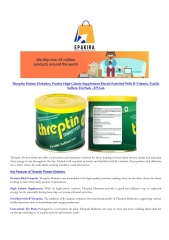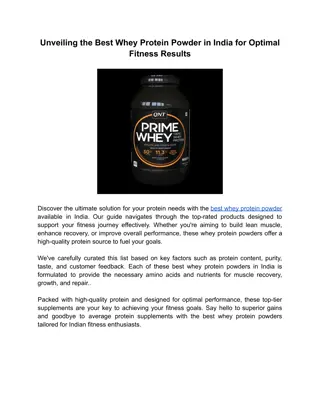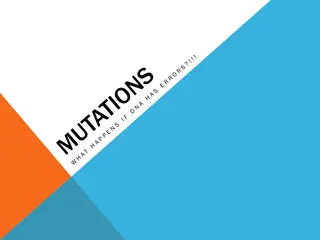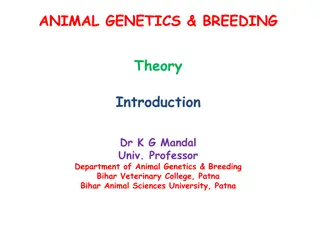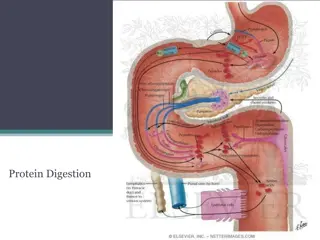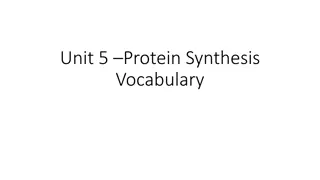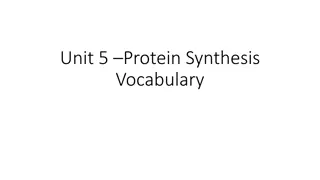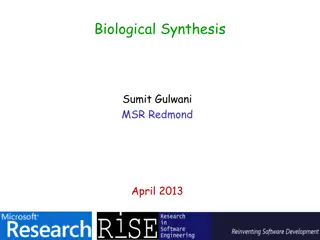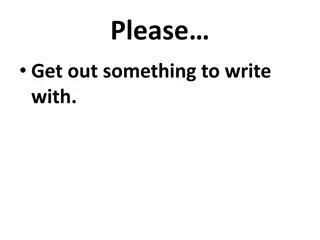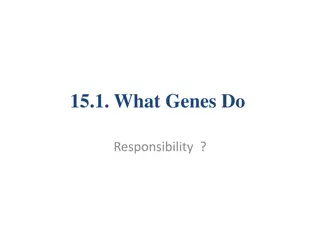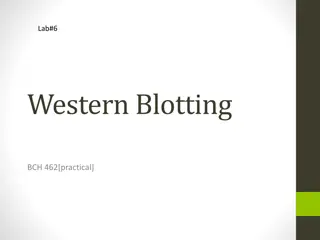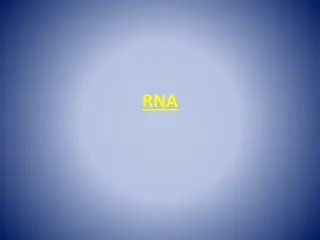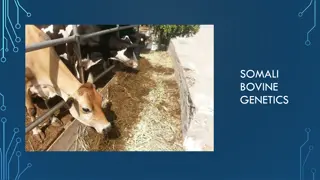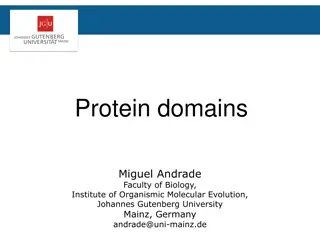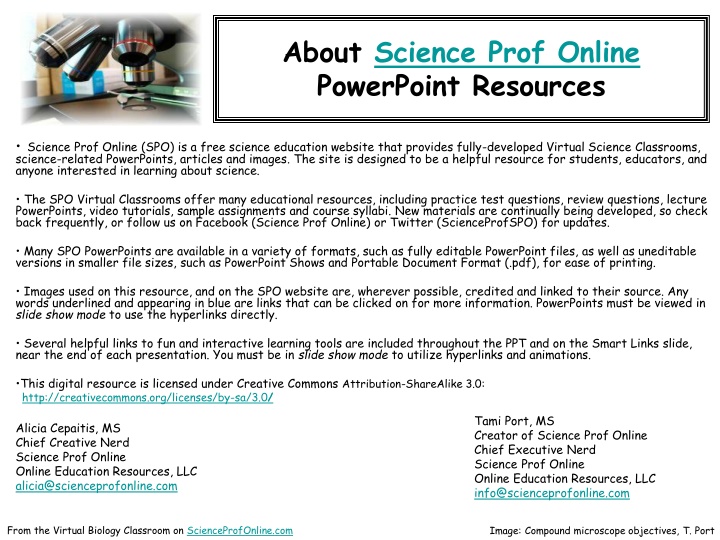
Virtual Science Classrooms and PowerPoints on Science Prof Online
Explore the free Virtual Science Classrooms and science-related PowerPoints on Science Prof Online (SPO) for a comprehensive science education experience. Access practice test questions, review materials, lecture PowerPoints, and more to enhance your understanding of science topics. Stay updated with new resources and follow SPO on social media for the latest updates.
Download Presentation

Please find below an Image/Link to download the presentation.
The content on the website is provided AS IS for your information and personal use only. It may not be sold, licensed, or shared on other websites without obtaining consent from the author. If you encounter any issues during the download, it is possible that the publisher has removed the file from their server.
You are allowed to download the files provided on this website for personal or commercial use, subject to the condition that they are used lawfully. All files are the property of their respective owners.
The content on the website is provided AS IS for your information and personal use only. It may not be sold, licensed, or shared on other websites without obtaining consent from the author.
E N D
Presentation Transcript
About Science Prof Online PowerPoint Resources Science Prof Online (SPO) is a free science education website that provides fully-developed Virtual Science Classrooms, science-related PowerPoints, articles and images. The site is designed to be a helpful resource for students, educators, and anyone interested in learning about science. The SPO Virtual Classrooms offer many educational resources, including practice test questions, review questions, lecture PowerPoints, video tutorials, sample assignments and course syllabi. New materials are continually being developed, so check back frequently, or follow us on Facebook (Science Prof Online) or Twitter (ScienceProfSPO) for updates. Many SPO PowerPoints are available in a variety of formats, such as fully editable PowerPoint files, as well as uneditable versions in smaller file sizes, such as PowerPoint Shows and Portable Document Format (.pdf), for ease of printing. Images used on this resource, and on the SPO website are, wherever possible, credited and linked to their source. Any words underlined and appearing in blue are links that can be clicked on for more information. PowerPoints must be viewed in slide show mode to use the hyperlinks directly. Several helpful links to fun and interactive learning tools are included throughout the PPT and on the Smart Links slide, near the end of each presentation. You must be in slide show mode to utilize hyperlinks and animations. This digital resource is licensed under Creative Commons Attribution-ShareAlike 3.0: http://creativecommons.org/licenses/by-sa/3.0/ Tami Port, MS Creator of Science Prof Online Chief Executive Nerd Science Prof Online Online Education Resources, LLC info@scienceprofonline.com Alicia Cepaitis, MS Chief Creative Nerd Science Prof Online Online Education Resources, LLC alicia@scienceprofonline.com From the Virtual Biology Classroom on ScienceProfOnline.com Image: Compound microscope objectives, T. Port
Molecular Genetics Basics Image: Peptide Synthesis Diagram: Boumphreyfr, Wiki; Replication Diagram: Madprime, Wiki From the Virtual Biology Classroom on ScienceProfOnline.com
Prokaryotic Genomes Made of DNA Chromosomes can be circular or linear Genome floats freely within cytoplasm Q: Where is DNA found in prokaryotes? ______________ ______________ From the Virtual Biology Classroom on ScienceProfOnline.com Image: Prokaryotic Cell Diagram: Mariana Ruiz
Eukaryotic Genomes Genomes of eukaryotic organisms made of DNA. Eukaryotic genomes frequently include many linear chromosomes within a membrane-bound nucleus (Q: How many do we have?). Where is DNA found in eukaryotes? Nuclear DNA Extranuclear DNA (Q: What is extranuclear DNA?) From the Virtual Biology Classroom on ScienceProfOnline.com Image: Eukaryotic Cell Diagram, Mariana Ruiz
Chromosomes & Genes Genome - Complete complement of an organism s DNA. Cellular DNA is organized in chromosomes. Genes have specific places on chromosomes. Image: Chromosome & gene, Graham Colm, National Human Genome Research Institute From the Virtual Biology Classroom on ScienceProfOnline.com
Nucleotides and Nucleic Acids From the Virtual Biology Classroom on ScienceProfOnline.com Image: DNA Detail Diagram: Madprime
Nucleic Acids Q: What type of monomer are nucleic acids made of? Image:Nucleotides.png From the Virtual Biology Classroom on ScienceProfOnline.com Image: Nucleotide Structure, Wikipedia
DNA Structure Double stranded molecule, analogous to a spiral staircase: - two deoxyribose-phosphate chains as the side rails - base pairs, linked by hydrogen bonds, are the steps (double ring) Adenine & Guanine Purine Bases Pyrimidine Bases (single ring) Cytosine & Thymine Images: Model of DNA Molecule, Field Museum, Chicago, T. Port; DNA Detail Diagram: Madprime; DNA Molecule, Biology Corner From the Virtual Biology Classroom on ScienceProfOnline.com
From the Virtual Biology Classroom on ScienceProfOnline.com Image: DNA molecule, Why Files, NSF
DNA Replication Copying of a double-stranded DNA molecule. Each DNA strand holds the same genetic information, so each strand can serve as a template for the new, opposite strand. The parent (a.k.a. __________ ) strand is preserved and the daughter (a.k.a. ___________) strand is assembled from nucleotides. This is called semi-conservative replication. Resulting double-stranded DNA molecules are identical. Q: Why would a cell need to copy its DNA? Image: Replication Diagram: Madprime, Wiki From the Virtual Biology Classroom on ScienceProfOnline.com
DNA Replication In a cell, DNA replication must happen before cell division. Prokaryotes replicate their DNA throughout the interval between cell divisions. In eukaryotes, timing of replication is highly regulated. Image: Prokaryotic Cell Diagram & Eukaryotic Cell Diagram, Mariana Ruiz From the Virtual Biology Classroom on ScienceProfOnline.com
DNA Replication Image: Types of Cell Division, Saperaud Wiki From the Virtual Biology Classroom on ScienceProfOnline.com
ReminderWhy is the DNA copied? Replication occurs prior to cell division, because the new, daughter cell will also need a complete copy of cellular DNA. Image: Types of Cell Division, Saperaud Wiki From the Virtual Biology Classroom on ScienceProfOnline.com
Replication Mistakes: Mutations of Genes Change in the nucleotide base sequence of a genome; rare. The problem: Wrong amino acid may result a non-functional Protein due to improper folding Almost always bad news, but... Rarely leads to a protein having a novel property that improves ability of organism and its descendants to survive and reproduce. From the Virtual Biology Classroom on ScienceProfOnline.com Images: Blinky & Bart, Matt Groening
Mutation and Bacterial Change _________ __________= When a microorganism is able to survive exposure to an antibiotic. Genetic mutation in bacteria can produce resistance to antimicrobial drugs (example: beta-lactamase). REVIEW! Antibiotic Resistance Animation from Sumanas If those genes are on a plasmid, they can be transferred between bacteria by conjugation and other forms of horizontal gene transfer. If a bacterium carries several resistance genes, it is called multidrug resistant (MDR) or, informally, a superbug or super bacterium. Any use of antibiotics can increase selective pressure in a population of bacteria to allow the resistant bacteria to thrive and the susceptible bacteria to die off. Image: Staphylococcus aureus on antibiotic test plate, PHIL #2641 From the Virtual Biology Classroom on ScienceProfOnline.com
Gene Expression Transcription & Translation (Making Proteins) From the Virtual Biology Classroom on ScienceProfOnline.com
Nucleic Acids: RNA Structure RNA is typically a single- stranded molecule. Purine Bases(double ring) Adenine & Guanine Pyrimidine Bases(single ring) Cytosine & _______ From the Virtual Biology Classroom on ScienceProfOnline.com Image: RNA, Biology Corner
Types of RNA Genetic information copied from DNA is transferred to 3 types of RNA: Copy of information in DNA that is brought to the ribosome where the information is translated into a protein. messenger(mRNA) is like a The protein factories of the cells. ribosomal(rRNA) is like a transfer (tRNA) are like a Brings the amino acid to the ribosome. Images: Blueprint, clipart; Factory, Andreas Praefcke; Truck, PRA; Ribosome translating protein, Xvazquez. From the Virtual Biology Classroom on ScienceProfOnline.com
Nucleic Acid Structure See SPO Class Notes article on Nucleotides & Nucleic Acids. From the Virtual Biology Classroom on ScienceProfOnline.com Image: Comparison of DNA & RNA, Wiki Commons
Transcription First Step of gene expression. Process by which a DNA sequence is copied to produce a complementary mRNA strand. In other words, it is the transfer of genetic information from DNA into RNA. Like replication, but making RNA. REVIEW Beginning of the process that ultimately leads to the translation of the genetic code (via mRNA) into a protein. Transcription Animations 1. mRNA Synthesis from McGraw-Hill 2. Transcription from WH Freeman Image: Transcription, National Human Genome Research Institute. From the Virtual Biology Classroom on ScienceProfOnline.com
Translation Second Step of gene expression. Anti-codon Ribosomes (which contain rRNA) make proteins from the messages encoded in mRNA. Codon The genetic instructions for a polypeptide chain are written in the DNA as a series of 3-nucleotide words. ______ on mRNA ___________ on tRNA U (uracil) replaces T in RNA This is the genetic code. Image: Codon-Anticodon pairing, Yikrazuul, Wiki; Peptide Synthesis Diagram: Boumphreyfr, Wiki. From the Virtual Biology Classroom on ScienceProfOnline.com
Translation REVIEW Translation Animations 1. How Translation Works from McGraw-Hill 2. Ribosome Building a Protein from Wikipedia Image: Peptide Synthesis Diagram: Boumphreyfr, Wiki From the Virtual Biology Classroom on ScienceProfOnline.com
Transcription & Translation Overview REVIEW Interactive animation that allows you to transcribe and translate a gene! See SPO Class Notes article on DNA Function: Transcription & Translation. From the Virtual Biology Classroom on ScienceProfOnline.com
Replication, Transcription, Translation MAKING DNA Making a copy of the genetic material = Replication When you think replication think duplication Q: Where does replication occur in prokaryotes? Eukaryotes? MAKING RNA Transferring genetic code (DNA) to RNA = Transcription Think of a medical transcriptionist copying the physicians words into another format. Q: Where does transcription occur in prokaryotes? Eukaryotes? MAKING PROTEINS Making proteins = Translation Think of how translation relates to languages. The translation of biology translates DNA information into proteins. Q: Where does translation occur in prokaryotes? Eukaryotes? Images: Replication Diagram: Madprime; Peptide Synthesis Diagram: Boumphreyfr, Wiki From the Virtual Biology Classroom on ScienceProfOnline.com
Hereditary Diseases are due to DNA mutations All inherited diseases arise from a mistake in the genetic code passed down from a person s parents, which leads to a defective protein. Image: Peptide Synthesis Diagram: Boumphreyfr, Wiki; Replication Diagram: Madprime, Wiki From the Virtual Biology Classroom on ScienceProfOnline.com
Genetic Disease: Cystic Fibrosis (CF) Most common, fatal genetic disease in the US. Causes body to produce thick mucus that: - clogs the lungs - leads to infections - blocks pancreas from delivering digestive enzymes to intestine. Results from mutations in a single gene: Cystic Fibrosis Transmembrane Regulator (CFTR) gene. In normal cells, the CFTR channel protein allows cells to release chloride and other ions. In people with CF, this protein is defective. Cells are not able to release chloride, resulting in an improper salt balance in the cells and thick, sticky mucus. Medical research is focusing on ways to cure CF by correcting the defective gene, or correcting the defective protein. CFTR channel protein controls flow of H2O and Cl- inside the lungs. When this protein is working correctly (Panel 1) ions can flow in and out of the cells. But, when the CFTR protein is blocked (Panel 2) these ions cannot flow out of the cell. Images: Health Problems of Cystic Fibrosis, Bruce Blaus Wiki, CFTR, Protein Channel, Wiki From the Virtual Biology Classroom on ScienceProfOnline.com
Genetic Disease: Sickle Cell Disease Sickle_cell.jpg Most common inherited blood disorder in US. Most prevalent among African Americans (~1 in 500) and Hispanic Americans (~1 in 1,000). Hemoglobin is the molecule in red blood cells (RBCs) that delivers oxygen from the lungs to the body s cells. Caused by a mutation in the hemoglobin-beta gene found on chromosome 11. People with this disorder have atypical hemoglobin, which can distort red blood cells into a sickle, or crescent, shape. Sickle shaped RBCs can pile up, rather than flow, causing blockages and damaging vital organs and tissue. People who only carry one copy of sickle cell gene typically don't get the disease, but can pass that defective gene on to their children. Children who get this trait from both parents get the disease (recessive trait). Image: Sickle Cell Diagram. Wiki From the Virtual Biology Classroom on ScienceProfOnline.com
Confused? Here are links to fun resources that further explain genetic transcription & translation: Smart Links Molecular Genetics: Replication Main Pageon the Virtual Cell Biology Classroom ofScience Prof Online. That Spells DNA song by Jonathan Coulton. DNA Structure Cell Biology Animation from John Kyrk. Build a DNA Molecule from University of Utah. DNA Replication animation and review questions. DNA Replication Process animated video by FreeScienceLectures.com. DNA Replication step-through animation by John Kyrk. Transcription & Translation Main Page on the Virtual Cell Biology Classroom ofScience Prof Online. DNA Transcription step-through animation by John Kyrk. Transcribe & Translate a Gene, from University of Utah. DNA Transcription and Protein Assembly animated movie by RedAndBrownPaperBag. Transcription and Translation animated movie from PBS production DNA: The Secret of Life. (You must be in PPT slideshow view to click on links.) From the Virtual Biology Classroom on ScienceProfOnline.com

